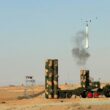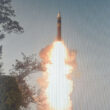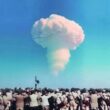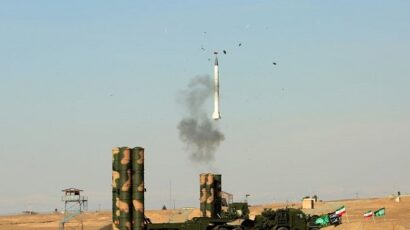New technology, familiar risks
By Rajaram Nagappa, June 25, 2015
Hypersonic missiles, if successfully developed, will cover long distances in a short time. Some observers argue that these missiles, in the hands of a nation that intended to overwhelm an adversary's early warning and missile defense systems, would pose a serious threat to global security and therefore should be banned. This is a contestable idea. The technology surrounding hypersonic missiles is still very much under development—but even if it is perfected, it will not add much to the security threats already posed by deployed weapons systems such as ballistic missiles.
Indeed, ballistic missile re-entry vehicles already operate at hypersonic velocities for a considerable part of their flight trajectory. For example, the re-entry vehicle of an intermediate-range ballistic missile whose range is, say, 3,000 kilometers travels at hypersonic speeds until it descends to an altitude of 30 kilometers (about 30 seconds from impact). But the threat that these weapons pose is generally accepted and accounted for. Sensors are capable of tracking ballistic missiles' flight. Missile defense systems are growing more robust.
The differentiation problem. Missiles travelling at hypersonic speeds—that is, at or above five times the speed of sound—offer the advantages of long range, high speed, and short flight times. No country has yet deployed a hypersonic system, but several are carrying out research and development. The main avenues of research are hypersonic cruise missiles and hypersonic glide vehicles. In nations pursuing hypersonic technology, glide vehicles appear to be the primary focus of development.
They can be used in combination with existing ballistic missiles (whether intercontinental, intermediate-range, or submarine-launched). The ballistic missiles would boost the glide vehicles to their release altitude, and the glide vehicles would then be allowed to glide downward at hypersonic speeds. Hypersonic cruise missiles, on the other hand, are boosted to operating altitude and velocity with an appropriate (non-ballistic) missile stage and are then powered by supersonic combustion ramjet (or scramjet) propulsion. The range of these missiles depends on the amount of fuel they can carry.
One potential problem that hypersonic missiles present is how to differentiate the launch of a conventionally-armed hypersonic glide vehicle or cruise missile from a strategic weapon launch. How are other nations to be certain what type of warhead a missile carries? Hypersonic missiles are also designed to be maneuverable—so it is possible to misunderstand a missile's intended destination. A nation might conclude, for example, that its nuclear forces were under attack when in fact its conventional forces were the intended target.
Impractical approach. The United States is the leader and trendsetter in hypersonic technology. Other countries are playing catch-up. China is now making investments in hypersonic missile technology, and more countries are bound to follow suit.
Whenever nations conduct tests that demonstrate the speed, range, precision, and accuracy of a weapons system, questions arise regarding that nation's intentions (as well as regarding the implications of the weapons system itself). Where hypersonic weapons are concerned, ambiguity surrounding national intentions is real. The result of this could be destabilization and perhaps even an escalatory conflict scenario. The solution to these problems, however, does not lie in banning hypersonic missile tests. Rather, it lies in understanding threats, managing them, and enacting confidence-building measures.
Even in the current scheme of things, with no hypersonic missiles deployed, ambiguity exists—when, for example, a nation's conventional and strategic missiles fall under a common command and control structure. And the missile launches of nations that carry out "anti-access/area denial" strategies can be ambiguous both in terms of warhead type and target.
Putting a moratorium on hypersonic testing is not the practical approach to solving such problems. The fact is that nations will make decisions about the deployment and testing of hypersonic weapons on the basis of relative power and competition. If the United States successfully develops hypersonic technology, one can be sure that Russia and China will do the same. Other countries, such as India, may follow. Nations at the early stages of hypersonic technology development won't wish to place themselves at a disadvantage to countries whose technology is more advanced. In fact, some nations would consider a moratorium on testing discriminatory.
And importantly, hypersonic technology has applications in the civilian space domain—in the areas of space transportation systems, re-entry capsules, and landing and reuse. Technological advancement in the civilian space realm requires testing, and nations with a stake in these civilian applications would oppose any mechanism that denied them the freedom to carry out tests.
Building confidence. Yes, hypersonic technology carries the risk that missile launches could be misidentified—but re-entry vehicles that are launched by ballistic missiles and re-enter at hypersonic speeds are not new. Understanding the re-entry trajectory of hypersonic missiles is complicated by maneuverable re-entry vehicles, but that is also true of existing ballistic missiles. The international community has responded to the ambiguity and escalatory risks of ballistic missiles with risk mitigation measures, detection and defense systems, and an effort to maintain a balance between deterrence and retaliation capabilities. This approach will need to be replicated for hypersonic missiles.
The United States has said it will use hypersonic missiles to supplement its conventional capabilities—not to deliver nuclear warheads. This is a welcome approach. Such a policy, from the very beginning of a conflict, could help keep the nuclear option at a remove. It is important for other nations developing hypersonic missile technology to adopt similar policies.
Another important step is to put in place confidence-building measures. These measures cannot involve only the United States and Russia, as often happened in the past; other countries that test hypersonic technologies, for either civilian or military applications, must be included as well. One important confidence-building measure would be to specify that hypersonic missiles will be used only with non-nuclear warheads. Other useful measures would include providing advance notice of tests; choosing separate, distinctive launch locations for tests of hypersonic missiles; and placing restraints on sea-based tests.
Technology for hypersonic missiles is still in the development stage. Production and deployment are not imminent. It is premature at this point to consider banning weapons tests—especially when hypersonic technology also has applications in the civilian realm. The best path forward is to use the time before deployment to debate the risks of hypersonic missiles and develop deterrents to their use—and to work out necessary confidence-building measures.
Topics: Nuclear Weapons
Share: [addthis tool="addthis_inline_share_toolbox"]














